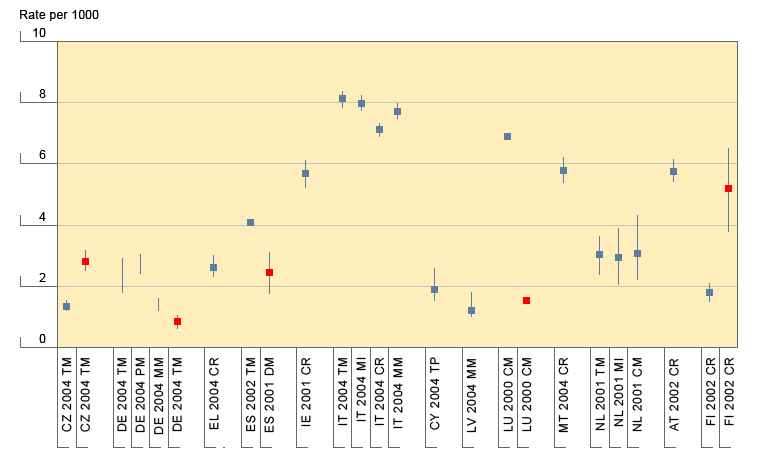Figure PDU-1: Estimates of the prevalence of problem drug use (rate per 1000 population aged 15 to 64), 2000 to 2004 – Part (iii) Estimates for opioids and stimulants

Notes:
Red symbols indicate stimulants use, other entries indicate opioid use.
CR=Capture-recapture; DM=Demographic method; TM =Treatment multiplier; PM = Police multiplier; MI = Multivariate indicator; TP= Truncated Poisson; CM = Combined methods; MM = Mortality multiplier.
For more details see Table PDU-1 to Table PDU-3.
The symbol indicates a point estimate, a bar indicates an uncertainty interval, which can be either a 95 %-confidence interval or an interval based on sensitivity analysis (see Table PDU-3)
Target groups may vary slightly owing to different methods and data sources; therefore comparisons should be made with caution.
The estimate of Czech Republic refers to the age group 18-64. In case of Luxembourg, since data was referring to the age group 15-54, a correction factor of 0.8519 was used to get an estimate for 15-64, under the assumption of no problem drug use in the age group 55-64.
Stimulants included methamphetamine in the 2004 Czech Republic estimate, cocaine and amphetamines in the 2004 Germany estimate, cocaine in the 2001 Spain estimate, non-opiates in the 2000 Luxembourg estimate and amphetamines in the 2002 Finland estimate.
See also 'General notes for interpreting data' on the Explanatory notes and help page.
Sources:
National Focal Points. See also EMCDDA project (2003): National prevalence estimates of problem drug use in the European Union, 1995–2000, CT.00.RTX.23, EMCDDA, Lisbon, coordinated by the Institut für Therapieforschung, Munich (http://www.emcdda.europa.eu/?nnodeid=1372). For Luxembourg population data see Eurostat.